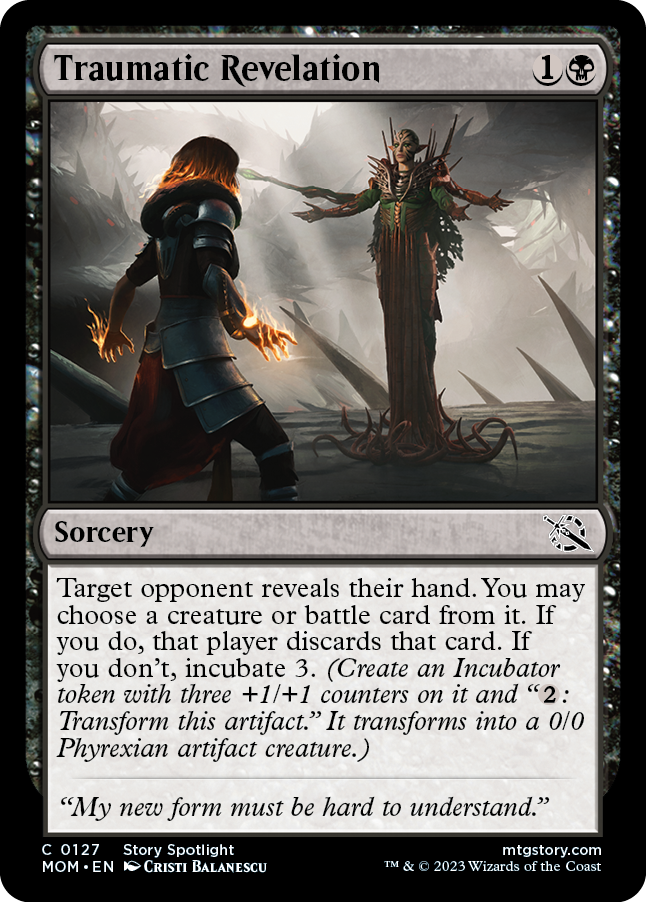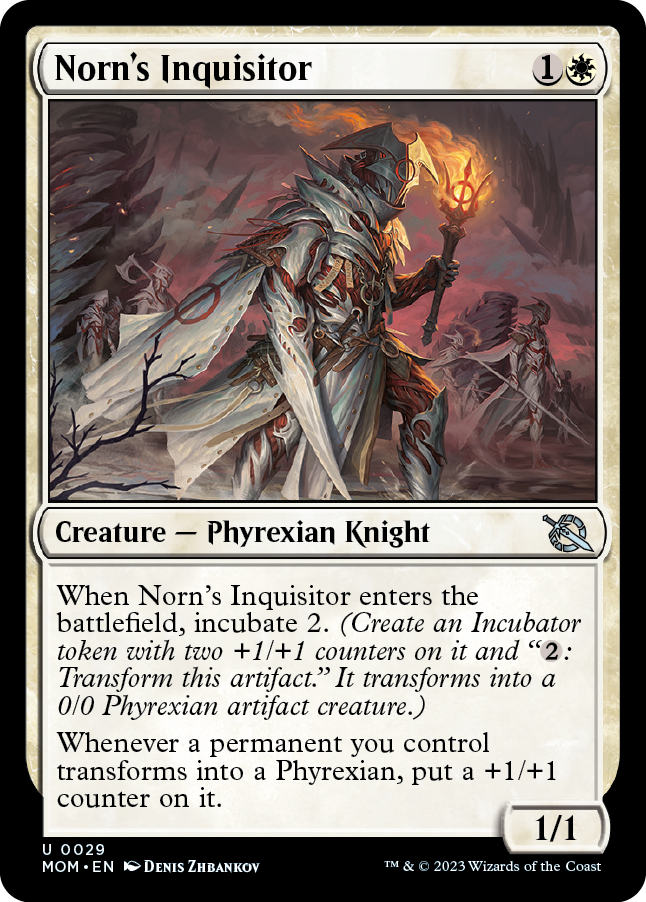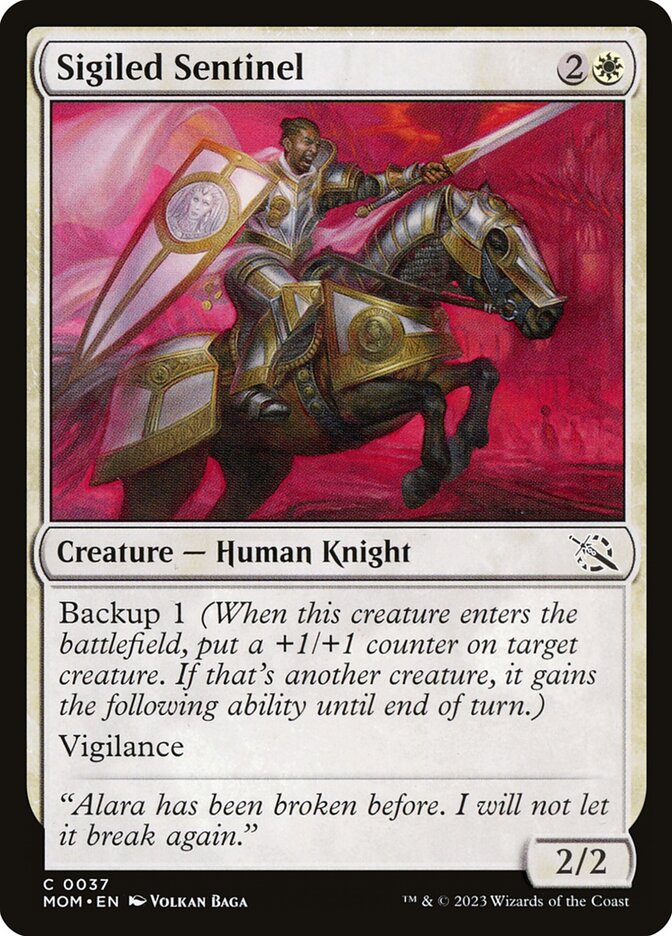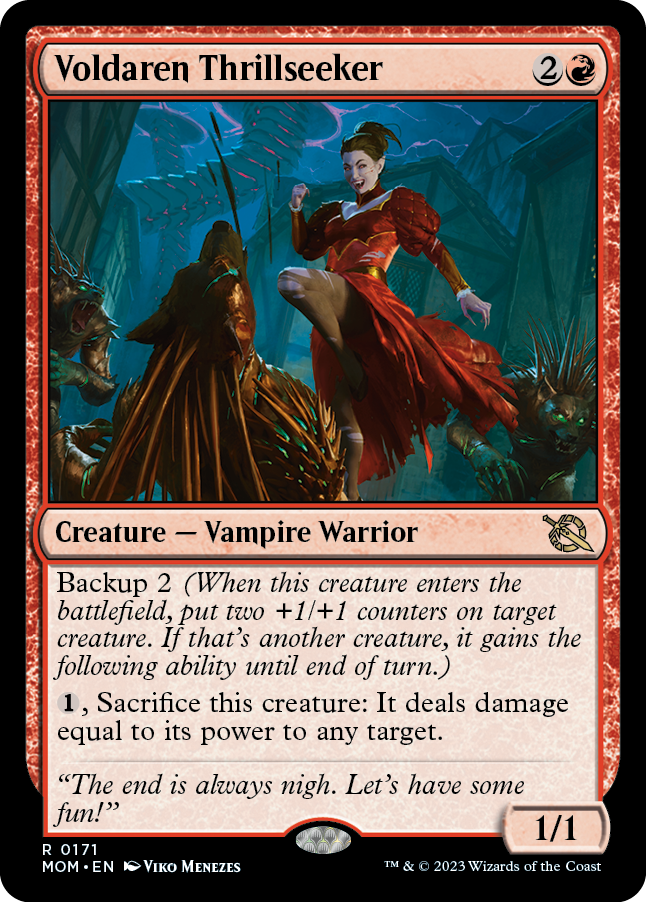|
|
Post by ameisenmeister on Apr 8, 2023 19:50:56 GMT
Hello MSE community, Whenever a new set is on the horizon and spoilers start, I'm mostly looking out for the new mechanics the set will feature. That's because mechanics - in my opinion - are the most important aspect of any set, as they carry the burden of linking gameplay to flavor, thereby carrying both. Flavorless (or rather flavorpoor) mechanics of the past, for example reinforce or the untap-symbol can feel disconnected from the set. On the other hand, flavorful mechanics like inspired can harm a set with gameplay issues. So what I'm going to do in this thread is looking at new mechanics (at least) of every new standard legal expansion and evaluate them according to certain criteria. For familiarity's sake, I'll use some of the criteria MaRo uses in his Storm Scale articles but also some of my own:
Design space - How many more cards could we design with this mechanic? Design space is important because if we can't make more cards, it doesn't matter how much players like it or how easy it is for development to balance. Versatility - How well does this mechanic mix and match with other mechanics? Does this mechanic require a lot of infrastructure or does it require minimal support? In short, does this mechanic make design easier or harder?
Complexity - How easy or hard is the mechanic to process for players? Do you have to be knees deep into the comprehensive rules to make use of it or can any new player get what's going on?
Novelty - Is the mechanic a new original or built upon an older one? Is it basically a reprint mechanic? Does it do something that few or no mechanic did before and add something innocative to the game?
Flavor - Is the mechanic flavorful within its setting, flavorful on its own or maybe not flavorful at all? Not every mechanic has to be a flavor home run, but being one sure doesn't hurt. Enjoyment - How does playing with the mechanic actually feel? This is obviously very subjective but I'll try to give comprehensible reasons for my opinions. The goal with this evaluation is twofold, though. I want to give my immediate reaction, basically right when I've seen a new mechanic for the first time, but I also want to offer more than educated guesswork. That's why I'm going to review a new set's mechanics twice - the first time before it is released and the second time after I got some drafts and construted games in. So hopefully I can provide a lot of content here for anybody who's interested in it. One last note before I start with March of the Machine's mechanics: What is a mechanic and what isn't is not always crystal clear. Is surveil a real mechanic? What about oil counters? And how about Naya's power-5-or-greater theme? I will try to go by a rule of thumb here: If it's a keyword used on five or more cards within a set, it's considered a mechanic. AND: If it is used to identify a faction within the set and has a certain recognition value, it is considered a mechanic too. So without further ado, let's start with the set that just got completely spoiled but not yet released: |
|
|
|
Post by ameisenmeister on Apr 8, 2023 20:33:57 GMT
The Phyrexia story arc is nearing its conclusion and with it come not only two hot new mechanics but also an old classic AND a brand new car type! Here are my thoughts before release: Incubate {Sample cards}   With treasures, clues and food, magic already had three of the four resources almost every deck can use implemented in token form - mana, card draw and life, respectively. The only thing missing until now was creatures, although one could argue that creature tokens are by far the most common kind of token produced anyway. With incubate, however, token generation received a new and interesting twist. Design space - How many more cards could we design with this mechanic? Design space is important because if we can't make more cards, it doesn't matter how much players like it or how easy it is for development to balance.
Versatility - Incubate is very versatile and can, theoretically, be put into any set without any support needed. In its core, it's just good old creature token creation. The only minor thing it could have is the doublesidedness of the created tokens presumably causing printing issues that make them harder to do as one-offs in sets that otherwise don't have DFCs. I don't understand what's the trouble in printing DFCs but I'm not a printing expert either so I just have to accept this. Incubate can also be used on any card type and the variable size of the created tokens makes for many easy and unproblematic designs.
Complexity - Having +1/+1 counters added to anything that's not a creature always feels unintuitive. Add the fact that the tokens can be transformed at instant speed and be turned into "surprise" blockers for new players and you have a mechanic that's on a slightly more complex side. The difficulties here are not with any game rules but with gameplay.
Novelty - The mechanic is as innovative as black bordered creture token creation can get, challenged maybe only by Hour of Devastation's amass keyword. It is the first time Magic has ever used double sided tokens and I believe it's a solid ground to expand upon in future releases.
Flavor - While maybe not an A+ hit within its set, incubate is very, very flavorful on it's own as a Phyrexian mechanic. The sole reason why I think it isN#t perfect for March of the Machine is that the Phyrexians in this set aren't presented as the insidious, infiltrating (=brooding) type of invaders but rather the shock and smash type. However, the mechanic is just perfect to visualize the culminating danger of Phyrexian infestation. The Phyrexian creature type on the transformed tokens will likely make it unusable for anything other than a Phyrexian setting.
Enjoyment - I expect Incubate to be a very interesting mechanic to play with. It will certainly add a lot of decision making to any game - regardless whether it will be you or your opponent having an untransfored token on their side. Do I leave mana open to transform my token if need be or do I rather spend the mana to play something else? Do I attack and bait the token's activation or do I stay in defense and risk that my opponent uses the open man to cast an instant at eot? Adding that this Phyrexian mechanic also plays well with proliferate from the previous set is just icing on the cake.
In total, I award incubate with 4.5/5 in the pre-played judgment. |
|
|
|
Post by ameisenmeister on Apr 9, 2023 20:46:23 GMT
Next mechanic I'll cover is Backup!
{Sample cards}  
Backup is like support on steroids. And here's why:
Design space - Theoretically, backup can give literally any creature ability. For some, it doesn't make sense because it's not relevant which creature has the ability. For others, the effect of having the ability twice for one turn just isn't that impactful. (A good example is Courser of Kruphix, which has been a heavily played card because of its abilities, but granting these abilities to another creature would be practically meaningless.) For the vast majority of creature abiltities however, having them granted to other creatures or doubling them for one turn is a pretty cool feat, so I consider backups design space pretty big. The only thing somewhat limiting its design space is the fact that it is ( albeit some weird shenanigans) purely a creature keyword.
Versatility - Backup uses +1/+1 counters, by far the most common type of counter, and requires no support from the set it's in. Theoretically, you could throw a single backup creature into any set and it wouldn't cause problems. That makes its versatility pretty high. Complexity - Some granted abilities might cause memory issues, but as they're always limited to the end of the turn, those should be absolutely minimal. Deciding where to place the counters is a process that requires a lot of thinking and min-maxing, but I think it's all in an intuitive and comprehesible way, so I expect the complexity will be just right. Novelty - Mechanics that grant +1/+1 counters are almost as old as mechanics themselves but fortunately the counters used in backup are more reminders than the thing the mechanic actually cares about. No, the core is the bestowing of keywords and other abilities and with that backup treads completetly new ground. The mechanic does something new and exciting while still being grokkable streamlined. Flavor - Here we come to a somewhat grey area. How exactly does the Gloomfang Mauler make another creature more threatening? Maybe it kind of works like a tag team: the mauler jumps into battle right beside the other creature, buffing it thereby and granting it its fearsome visage. But why does the buffed creature retain the granted power and toughness boost yet not the menace? It gets even weirder with Scorn-Blade Berserker which DOES make a creature stronger but at the same time makes it develop suicidal tendencies. Backup is not a complete flavor fail in my eyes but flavor isn't really its strongest suit either.
Enjoyment - Seeing the newly spoiled cards with backup doesn't only make we want to play with them and the new set but also gets my gears turning and thinking about new combo ideas, for limited and beyond. I very much expect this mechanic to be a hit to play and brew with.
In total, I award incubate with 5/5 in the pre-played judgment.
|
|
|
|
Post by ameisenmeister on Apr 10, 2023 21:10:03 GMT
Now I look at convoke, the set's returning mechanic: Design space - As a cost reduction mechanic, convoke's design space is vast and it can literally be used on every card type except lands, while instants and spells with flash profit the most. I remember reading that wotc had toyed with the idea of activated abitlity convoke but eventually didn't use it. I think it's a neat idea - with obviously a much smaller design space - that we'll probably see sometime in the future. Versatility - Convoke needs support from the rest of the set to really shine, but what and how much depends on the colors it's supposed to work in. With the   Selesnya Guild convoke is a natural fit because both colors naturally create a lot of small tokens and at least white has easy access to creatures with vigilance. In March of the Machine, convoke is used in  and  , which makes things more difficult. The set was designed to support the mechanic by giving both colors access to a variety of tokens. Blue creates some knights (even with vigilance) and Phyrexian tokens from incubate, while red creates multicolored elementals. Whether the given support is enough to make convoke a worthwhile mechanic in limited remains to be seen. Complexity - The functionality of Convoke is pretty straightforward: Tap your creatures as though they were lands. Nifty tricks like using creatures with vigilance or tapping creatures after blocks are picked up by players along the way. Convoke has no problems when it comes to the rules and is also easy to use. However, because it theoretically can allow players who are tapped out to still cast instant spells, Convoke has the potential of causing moments of frustration, especially for newer players. Finally deciding to attack and then getting completely blown out by an out-of-the-blue Crowd's Favor is probably a devastating experience for everybody who's still trying to get a grip of board states. Novelty - Convoke is a returning mechanic and therefore obviously not inventing anything new. However, new is the fact that it is used in  , the color with the lowest share of creatures and also the one last in creature token production. That at the very least makes for convoke spells that haven't been there before. How fresh it will really feel is something that probably can't be said in advance. Flavor - It's flavorful. Magic is full of creatures that can - well - wield magic. And some spells are special, use a special form of magic or whatever, and can be cast with the assistance of people who otherwise can't tap leylines for mana. It's maybe a little tricky with artifact creatures but even those tend to have some magical power source. Enjoyment - Having played a lot with the mechanic I can personally say that it is a very enjoyable. The decisions on whether to tap a creature for convoke or leave it untapped to attack or block feels challenging at times but rarely overwhelming. And casting big spells with the help of a giant mass of creatures is every Timmy/Tammy's dream come true. In total, I award convoke with 4.5/5 in the pre-played judgment. |
|
|
|
Post by ameisenmeister on Apr 11, 2023 22:48:44 GMT
And now it's finally time to look at the last thing on the March of the Machine list: Sieges
But first some clarifying words: I know that the actual new thing isn't the sieges but the new card type Battle of which sieges are just a subtype. But as I - at the time of writing - do not know what exactly a Battle is and what makes it different from a siege, the subtype is the thing I'm going to talk about for now. Let's see what wotc comes up with next and what just actually is a Battle.
Design space - Sieges have a huge number of knobs to change and play with. Different etb effects - static effects even, different number of defense counters, different mana costs and of course vastly different backsides for when the siege is actually broken. Anything nonland can work here, although strictl instant speed effects (countering, killing attacking or blocking creatures, etc.) don't make sense unless you're setting up shenanigans. From the perspective of what different things can be done with the new card (sub)type, the possibilities are almost endless.
Versatility - Although sieges matter is an actual limited archetype in March, it's not really a necessity for having sieges in a set. Like with most mechanics of the set, this too can be put into any set and probably will, similar to how wotc uses Sagas in a lot of sets now. The only thing that sieges need in order to work are creatures that attack and that's something every set has.
Complexity - Alternative attacking target, a relevant backside that can theoretically be activated at instant speed via burn spells, sieges are really a lot to unpack. Adding the fact that you choose an opponent as the siege's protector but are then allowed to attack it is something so new that it will likely raise some rules confusion. The decisions that playing with or against a siege brings with it are challenging and evaluating whether it's worth to damage the siege or just to go for the opponent's face is too. I might not have played with sieges already but I dare to say that it's probably one of the most complex mechanics that wotc designed in a long time.
Novelty - Whether a mechanic is really novel can kind of be seen by the reactions it receives when revealed. And sieges definitely got some reactions. There are quite a number of people who strongly dislike them and at least that many people who are already in love with them. Which camp will turn out to be more in the right remains to be seen but no side can deny that sieges are doing things that Magic hasn't seen before. Sieges are like a team up of Planeswalker and transform into a minigame that influences the main game. So all in all I'd say that novelty maybe is the strongest suit of sieges.
Flavor - Flavorwise, sieges sre a mixed batch for me. Having to break a siege by attacking and pushing through is flavorful, and reaping a reward also works. It's weird, however, that you, as the caster of the siege, basically decide when the siege begins, giving you opportunities to set up plays where you play the siege and then immediately end it. Gameplay beats flavor, though, and I have to point out that, at least in March of the Machine, sieges get an extra flavor point because Phyrexians can prolong them by using proliferate.
Enjoyment - Because nobody has ever played something remotely similar to sieges, it's very hard to evaluate the fun they might or might not bring. But here are some aspects why I think sieges will be healthy for the game: Combat matters! A lot of standard environments have been ruined hampered by the cultivation of control and/or superfriends decks, where people just wouldn't play any creatures and instead had their planeswalkers all the heavy lifting while repeatedly clearing the field with sweepers and spot removal. If you want to play sieges, however, you are very much inclined to use creatures and lower yourself into the depths of attacking, blocking, and other things that make Magic fun and interactive. Control decks can't just leave through the first hits and gain life back later in the game when it wasn't their life total being attacked but a siege that will give the opponent the edge in later turns. Aggro players can't just attack willy nilly and leave themselves open to counterattacks when there's a siege to be protected. Of course all these things can still happen but I think (and hope) that sieges will give the cambat step more weight and with that bring back some of the fun that sometimes gets lost in the higher echelons of competitive playing.
In total, I award sieges with 4.5/5 in the pre-played judgment. But I am still very weary in that decision as they can easily turn out to be a horrible idea.
|
|







 Selesnya Guild convoke is a natural fit because both colors naturally create a lot of small tokens and at least white has easy access to creatures with vigilance. In March of the Machine, convoke is used in
Selesnya Guild convoke is a natural fit because both colors naturally create a lot of small tokens and at least white has easy access to creatures with vigilance. In March of the Machine, convoke is used in  and
and  , which makes things more difficult. The set was designed to support the mechanic by giving both colors access to a variety of tokens. Blue creates some knights (even with vigilance) and Phyrexian tokens from incubate, while red creates multicolored elementals. Whether the given support is enough to make convoke a worthwhile mechanic in limited remains to be seen.
, which makes things more difficult. The set was designed to support the mechanic by giving both colors access to a variety of tokens. Blue creates some knights (even with vigilance) and Phyrexian tokens from incubate, while red creates multicolored elementals. Whether the given support is enough to make convoke a worthwhile mechanic in limited remains to be seen.